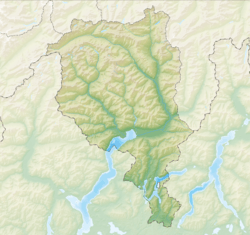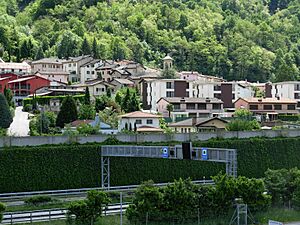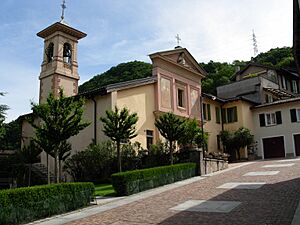Grancia facts for kids
Quick facts for kids
Grancia
|
||
|---|---|---|
|
||
| Country | Switzerland | |
| Canton | Ticino | |
| District | Lugano | |
| Area | ||
| • Total | 0.61 km2 (0.24 sq mi) | |
| Elevation | 320 m (1,050 ft) | |
| Population
(Dec 2020 )
|
||
| • Total | 477 | |
| • Density | 782/km2 (2,025/sq mi) | |
| Postal code |
6921
|
|
| Surrounded by | Collina d'Oro, Lugano | |
Grancia is a small town, called a municipality, located in the Lugano area of Ticino, a canton (like a state) in Switzerland.
Contents
History of Grancia
Grancia was first mentioned in old writings way back in 1309. Until 1825, it was part of a nearby town called Carabbia.
In the late 1200s, a religious group in Grancia was connected to a monastery in Torello (now part of Carona). People say that during the Middle Ages, Grancia had the biggest granary (a place to store grain) around. Most of the grain came from Brusimpiano and was ground into flour at mills along the Pian Scairolo river.
The church of S. Carpoforo was likely built in the 1500s on top of an even older church. This church, along with S. Siro in Carabbia, belonged to the parish (a church district) of S. Pietro in Pambio. In 1608, Grancia and S. Siro became their own parishes. Then, in 1670, Grancia separated from S. Siro to have its own church.
For a long time, the town's economy mainly depended on farming. In the 1800s, a brick factory opened. In recent decades, more factories and businesses have grown around Grancia. This growth has led to large shopping malls and new homes. Being close to the A2 motorway (a big highway) and having huge storage tanks has changed the look of the village.
Geography of Grancia
Grancia covers an area of about 0.63 square kilometers (0.24 square miles). A good portion of this land, about 23.8%, is used for farming. Forests cover about 38.1% of the area.
About 49.2% of Grancia's land is built up with buildings and roads. This includes industrial buildings, houses, and transportation routes. A small part, about 4.8%, is made up of rivers or lakes.
Grancia is located in the Lugano district. The municipality includes the main village of Grancia and four smaller sections, one of which is Campestro.
Grancia's Coat of Arms
The blazon (description) of Grancia's municipal coat of arms is: a blue shield with a red pilgrim's stick on a silver stripe, placed between two golden millet ears.
Population and People
Grancia has a population of about 500 people. As of 2008, about 35.3% of the people living in Grancia were foreign nationals. Over ten years, from 1997 to 2007, the population grew by almost 30%.
Most people in Grancia speak Italian, which is 88% of the population. German is the second most common language, spoken by about 6.3% of residents.
In 2009, about 9.7% of the population were children aged 0 to 9 years old. Teenagers, aged 10 to 19, made up about 12.7% of the population. Adults between 20 and 59 years old made up a large part of the population, around 60%. About 17.9% of the population were seniors aged 60 and older.
In 2000, there were 145 homes in Grancia, with an average of 2.5 people living in each home. Most of the inhabited buildings were single-family homes.
The chart below shows how Grancia's population has changed over time:

Economy and Jobs
In 2007, Grancia had an unemployment rate of 4.45%. This means a small percentage of people looking for work couldn't find a job.
The economy is divided into three main parts:
- Primary sector: This includes jobs like farming and forestry. In 2005, only a few people worked in this area in Grancia.
- Secondary sector: This involves manufacturing and construction. About 133 people worked in this sector.
- Tertiary sector: This includes services like shops, offices, and hotels. This is the largest sector in Grancia, employing 767 people.
Many people travel into Grancia for work. In 2000, over 1,100 workers came into the town, while only 145 left to work elsewhere. This shows that Grancia is a place where many jobs are located. Most people, about 65.8%, used a private car to get to work.
Religion
According to the 2000 census, most people in Grancia, about 78.4%, were Roman Catholic. A smaller group, about 4.4%, belonged to the Swiss Reformed Church.
Education
Switzerland is known for its good education system. In Grancia, about 61.4% of adults (aged 25–64) have completed either high school or gone on to higher education, like a university.
In 2009, there were 95 students in Grancia. The education system in Ticino, the canton Grancia is in, offers:
- Kindergarten: Up to three years of non-mandatory kindergarten. In Grancia, 16 children were in kindergarten.
- Primary School: This program lasts for five years. In Grancia, 19 students attended standard primary schools.
- Lower Secondary School: Students can choose between a two-year middle school followed by a pre-apprenticeship, or a four-year program to prepare for university.
- Upper Secondary School: This prepares students for a trade or for university. Many students attend vocational schools, either full-time or part-time while doing an internship.
In 2000, 57 students from Grancia went to schools outside the municipality.
See also
 In Spanish: Grancia para niños
In Spanish: Grancia para niños







